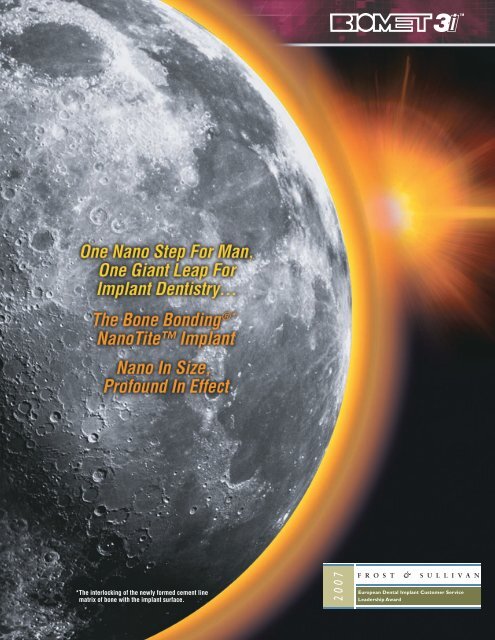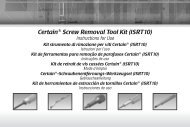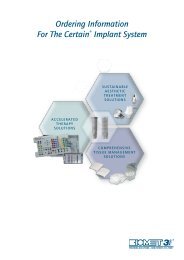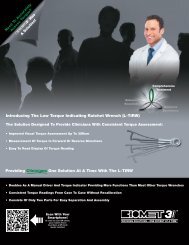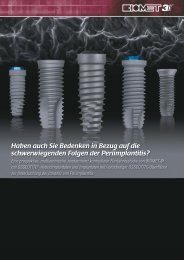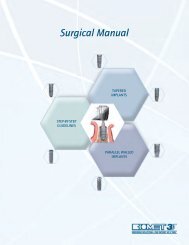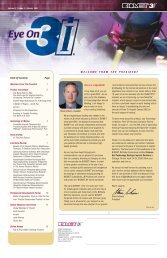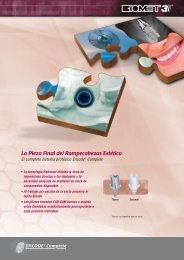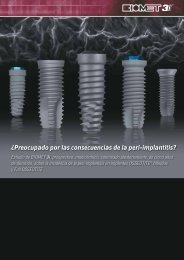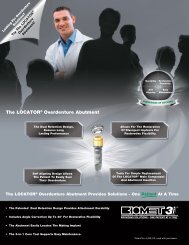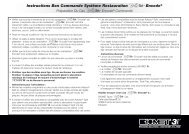NanoTite ⢠Implant Brochure - Biomet 3i
NanoTite ⢠Implant Brochure - Biomet 3i
NanoTite ⢠Implant Brochure - Biomet 3i
Create successful ePaper yourself
Turn your PDF publications into a flip-book with our unique Google optimized e-Paper software.
*The interlocking of the newly formed cement line<br />
matrix of bone with the implant surface.
The Revolutionary <strong>NanoTite</strong> <strong>Implant</strong> –<br />
A Bone Bonding ® Surface<br />
• Microtopography Of The OSSEOTITE ® <strong>Implant</strong> Combined With<br />
A Nanometer-scale Discrete Crystalline Deposition (DCD)<br />
Of Calcium Phosphate (CaP) Creates A More Complex Surface<br />
Topography. This Renders The <strong>NanoTite</strong> <strong>Implant</strong> A Bone<br />
Bonding Surface By The Interlocking Of The Newly Formed<br />
Cement Line Matrix Of Bone With The <strong>Implant</strong> Surface1, 16<br />
• Preclinical Studies Demonstrate A Substantial Improvement<br />
On The Rate And Extent Of Osseointegration For The<br />
<strong>NanoTite</strong> <strong>Implant</strong> Versus The OSSEOTITE <strong>Implant</strong><br />
Leading To <strong>Implant</strong> Stability 12<br />
• <strong>NanoTite</strong> <strong>Implant</strong>s May Be Used For Immediate Function<br />
On Single Tooth And/Or Multiple Tooth Applications When<br />
Good Primary Stability Is Achieved, With Appropriate<br />
Occlusal Loading, In Order To Restore Chewing Function<br />
Interface Of Cement Line Matrix And DCD Treated<br />
<strong>Implant</strong> Surface<br />
Photo Courtesy Of:<br />
John E. Davies,<br />
BDS, PHd, DSc, FSBE
Why <strong>NanoTite</strong> <br />
BIOMET <strong>3i</strong>’s OSSEOTITE ® Surface has more than a decade<br />
of clinical use and evidence based research to support its<br />
efficacy, so why is another surface needed 2-9 As treatment<br />
protocols get more advanced and dental implants are placed<br />
in more challenging clinical scenarios, there could be a<br />
benefit to a surface that provides a greater rate and extent<br />
of osseointegration on a more predictable basis. Potential<br />
scenarios where such an implant might be beneficial to<br />
patient and practice might include the following:<br />
• Immediate And Accelerated Loading Protocols<br />
• Immediate Replacement In Extraction Sockets<br />
• Simultaneous Grafted Sites And <strong>Implant</strong> Placement<br />
• Aesthetic Areas Where Bone Preservation Is Critical<br />
• <strong>Implant</strong> Placement In Poor-Quality Bone<br />
• Locations Requiring Short Or Wide <strong>Implant</strong>s<br />
<strong>Implant</strong>s typically demonstrate good primary stability at the<br />
time of placement – in principle, a mechanical phenomenon.<br />
As bone remodels in subsequent weeks, there can be a<br />
reduction in implant stability that might impact early or<br />
immediate loading protocols.*<br />
Now with the next generation surface technology, the <strong>NanoTite</strong><br />
<strong>Implant</strong> incorporates the complex architecture at the nanoscale,<br />
which renders it a Bone Bonding ® Surface. † Preclinical<br />
studies have shown that the surface on the <strong>NanoTite</strong> <strong>Implant</strong><br />
results in significantly enhanced integration compared to<br />
OSSEOTITE Control <strong>Implant</strong>s. 12 This enhanced osseointegration<br />
is occurring at early time points. 15 BIOMET <strong>3i</strong> is actively<br />
investigating via resonance frequency analysis the ability for<br />
the <strong>NanoTite</strong> <strong>Implant</strong> to produce a more Steady State<br />
Stability ‡ Condition in the early phases of healing.<br />
* Adapted from: Raghavendra S, Wood MC, Taylor TD. Early wound healing around endosseous<br />
implants: a review of the literature. Int J Oral Maxillofac <strong>Implant</strong>s. 2005 May-Jun;20(3):425-31.<br />
† Bone Bonding is defined as the interlocking of the newly formed cement line matrix with the<br />
implant surface.<br />
‡ BIOMET <strong>3i</strong> defines Steady State Stability as maintaining the primary stability achieved at the<br />
time of surgery with minimal to no drop-off in implant stability due to bone remodeling.<br />
It All Starts With The Proven OSSEOTITE ® Surface…<br />
For more than 10 years, with documentation<br />
from numerous global multicenter clinical<br />
evaluations, the OSSEOTITE Surface has proven<br />
to be a predictable and well-researched surface 2-9 .<br />
Clinical studies on the OSSEOTITE Surface continue to<br />
document the benefits of increased contact osteogenesis,<br />
especially in poor-quality bone. 6<br />
OSSEOTITE Surface at 20,000x magnification
...And It Gets Better With The Nano-Scale<br />
Discrete Crystalline Deposition (DCD ) Process<br />
An Innovative <strong>Implant</strong> Surface Technology<br />
The Unique Patented Process:<br />
1. Nanometer-scale, ultra small particles of highly Crystalline<br />
Calcium Phosphate (CaP) are suspended in the solution<br />
2. These particles are then prompted to “Self-Assemble” onto the implant<br />
titanium oxide surface<br />
3. This results in discrete crystal deposits of 20-100 nanometers in<br />
length on the dual acid etched OSSEOTITE ® <strong>Implant</strong> Surface. The shear<br />
strength of crystal attachment to the OSSEOTITE Surface exceeds the<br />
minimum shear strength value of 34.5 MPa set by the ASTM standard<br />
(F 1609-03) for attachment of traditional HA coatings to implant surfaces 11<br />
1<br />
2<br />
3<br />
<strong>NanoTite</strong> Surface at 20,000x magnification
Using The Best Of Both Worlds<br />
The <strong>NanoTite</strong> <strong>Implant</strong> builds on the success of the<br />
OSSEOTITE ® Surface by creating a more complex surface<br />
topography and maximizing the potential biological benefits<br />
of calcium phosphates (CaP).<br />
Traditionally, CaP has been plasma sprayed on the implant<br />
surface, creating a coating thickness typically in the range of<br />
50-100 microns. The nature of plasma sprayed coatings makes<br />
them susceptible to events such as delamination or dissolution<br />
of the amorphous content of the coating.* Hence the positive<br />
attributes of CaP may be offset by certain risk factors.<br />
The <strong>NanoTite</strong> <strong>Implant</strong> is different. The CaP is not applied via a<br />
plasma sprayed process but rather a solution based form of<br />
self-assembly. It is not a continuous coating but consists of<br />
actual deposits of discrete crystals that occupy approximately<br />
50% of the OSSEOTITE ® Surface. The total amount of CaP<br />
material on a <strong>NanoTite</strong> <strong>Implant</strong> is so small that it weighs less<br />
than 20 micrograms (or about one-third the weight of one<br />
grain of ordinary table salt). This is in contrast to the 20,000<br />
micrograms of CaP on the typical plasma sprayed surface –<br />
a one thousand fold difference.<br />
The dissolution of DCD on a <strong>NanoTite</strong> <strong>Implant</strong> is extremely<br />
low in physiologically neutral pH given the highly crystalline<br />
nature of the CaP crystals. This provides implants with a more<br />
consistent and stable phase of CaP, allowing the implant site<br />
to capitalize on the positive attributes of this biomaterial. In<br />
addition, the DCD Process increases the micro-surface area<br />
by 200%, providing greater microcomplexity.<br />
HA Surface<br />
at 2000x magnification<br />
<strong>NanoTite</strong> Surface<br />
at 2000x magnification<br />
At 2000x magnification, the contiguous coating is clearly<br />
evident with a plasma-sprayed implant, while at the same<br />
magnification, there is no visible change in the microtopography<br />
of a <strong>NanoTite</strong> <strong>Implant</strong>. At 20,000x magnification, these<br />
nano-scale discrete deposits become visible.<br />
(See image opposite page)<br />
Dissolution Of Discrete<br />
Calcium Phosphate Crystals vs. Plasma Sprayed HA 10<br />
(Micrograms Of Ca Dissolution At Various pH)<br />
<strong>NanoTite</strong> <strong>Implant</strong> vs. HA Plasma Sprayed <strong>Implant</strong><br />
* Adapted from: Ong JL, Chan DC. Hydroxyapatite and their use as coatings in dental implants: a review. Crit Rev Biomed Eng. 2000;28(5-6):667-707.
Researchers Are Seeing Impressive Results<br />
Benchtop Testing<br />
Both quantitative and qualitative benchtop performance tests<br />
demonstrate superior adhesion strength of the nano-scale crystals to the OSSEOTITE ® <strong>Implant</strong><br />
Preclinical Studies<br />
A comprehensive series of animal studies were performed on the <strong>NanoTite</strong> Surface in various animal models.<br />
Further, these studies conclusively demonstrated that the <strong>NanoTite</strong> Surface results in a greater rate and extent of<br />
osseointegration as compared to the OSSEOTITE Surface alone. The micro-topography of the OSSEOTITE Surface combined<br />
with the nanometer-scale architecture created with the <strong>NanoTite</strong> Surface Treatment renders it a Bone Bonding ® Surface by the<br />
interlocking of the newly formed cement line matrix of bone with the implant surface.<br />
Bone that has undergone osteoclastic resorption demonstrates a unique surface complexity not all that dissimilar from the<br />
<strong>NanoTite</strong> Surface complexity. The nanoscale topography of the <strong>NanoTite</strong> <strong>Implant</strong> is thought to play<br />
a significant role in the osseointegration potential of this implant.<br />
Osteoclastic Resorption Image<br />
Courtesy of J.E. Davies, BDS, PhD, DSc,<br />
FSBE University of Toronto<br />
<strong>NanoTite</strong> Surface<br />
at 20,000x magnification
Ongoing Preclinical And Clinical Studies<br />
Numerous prospective human trials have been initiated with the <strong>NanoTite</strong> <strong>Implant</strong> and global evaluation of the product has<br />
been in progress since June of 2006. These human protocols were specifically designed to assess the comparative performance<br />
of the <strong>NanoTite</strong> <strong>Implant</strong> in more challenging clinical indications to include immediate loading. Human histology has also been<br />
procured demonstrating a substantive increase in Bone-To-<strong>Implant</strong>-Contact (BIC) with the <strong>NanoTite</strong> Surface.<br />
®<br />
Bone-To-<strong>Implant</strong>-Contact Outcome<br />
At Eight Weeks Of Healing<br />
Human histological sections have<br />
demonstrated an impressive amount<br />
of bone to implant contact around the<br />
<strong>NanoTite</strong> Surface, further supporting<br />
its unique potential for osseointegration.<br />
Int J Periodontics Restorative Dent, 2007;27:211-219
Surface And Design Technology<br />
That’s Out Of This World<br />
• The <strong>NanoTite</strong> PREVAIL ® <strong>Implant</strong> incorporates integrated<br />
platform switching and an internal connection with the<br />
OSSEOTITE ® Surface and nano-scale crystals to the top of<br />
the collar, creating a continuous bone-loading surface<br />
• The <strong>NanoTite</strong> Straight Collar PREVAIL <strong>Implant</strong> provides<br />
users the benefits of the PREVAIL <strong>Implant</strong> in a straight<br />
collar design to allow for flexibility in tight interdental<br />
spaces or where ridge width is limited<br />
• The <strong>NanoTite</strong> Tapered PREVAIL <strong>Implant</strong> includes benefits<br />
of the PREVAIL <strong>Implant</strong> in a tapered design for indications<br />
where a natural tooth root shape is preferred and early<br />
stability is desired<br />
• The <strong>NanoTite</strong> Tapered <strong>Implant</strong> closely approximates<br />
the shape of a natural tooth root with the OSSEOTITE<br />
Surface and nano-scale crystals to the base of the<br />
implant collar<br />
• The <strong>NanoTite</strong> Certain ® <strong>Implant</strong> provides an internal<br />
connection and has coverage of both the OSSEOTITE Surface<br />
and nano-scale crystals to the base of the implant collar<br />
• The <strong>NanoTite</strong> External Connection <strong>Implant</strong> has coverage<br />
of both the OSSEOTITE Surface and nano-scale<br />
crystals to the base of the implant collar
What Your Peers Are Saying About<br />
The <strong>NanoTite</strong> TM <strong>Implant</strong><br />
Dennis Tarnow, DDS, New York, NY<br />
“It’s very exciting to us as clinicians and as academicians<br />
because this discrete deposited nano technology allows<br />
for the best of both worlds. Without having a full coating<br />
on the implant, you now have a surface that will integrate...<br />
that’s the regular OSSEOTITE ® ...combined with something that acts as an<br />
attractor to the bone and in fact might allow for actual deposition of bone<br />
on the electron microscope level.”<br />
Robert Emery, DDS, Washington, D.C.<br />
“We try to stay at the cutting edge of oral and maxillofacial surgery<br />
and especially implant dentistry because we do such a large amount<br />
of implant surgery. To stay at the cutting edge you have to evaluate<br />
new products and see if they improve patient care. This “DCD ”<br />
Technology or the Nano Calcium Phosphate is probably the biggest improvement<br />
that's hit implant dentistry in the past few years. It’s a big step forward.”<br />
Markus Hürzeler, DMD, PhD, Munich, Germany<br />
“We have already treated patients in one day. We placed implants<br />
and we immediately placed some teeth on those implants and<br />
we had a pretty good success rate. But now, with this new<br />
technology, I am pretty sure that in the future, we will have an<br />
even better success rate with this approach and if you have the opportunity to<br />
give the patient…that you come in the morning to the office and get implants…<br />
you get the teeth right away...in the same day…this I think is a big advantage<br />
and a big effect for the patient.”<br />
J. E. Davies, BDS, PhD, DSc, FSBE, Toronto, Canada<br />
“Certainly these results are incredible.<br />
I don’t think it’s because we’ve discovered<br />
a new phenomenon in biology, but certainly<br />
the interface which has been created between<br />
bone and this particular implant surface is quite different<br />
from anything ever seen before.”<br />
BIOMET <strong>3i</strong> LLC, as the manufacturer of medical<br />
devices, does not practice medicine and does<br />
not recommend particular devices or surgical<br />
techniques for any particular patient. These<br />
testimonials are the expressed opinions of the<br />
respective clinicians and researchers. The<br />
clinicians and researchers are not agents or<br />
employees of BIOMET <strong>3i</strong> and BIOMET <strong>3i</strong> is not<br />
responsible for the expressed opinions,<br />
instructions or recommendations made therein.<br />
BIOMET <strong>3i</strong> does not guarantee any particular<br />
results or benefits and disclaims any liability<br />
regarding whether the use of the information or<br />
products in this brochure will or will not achieve<br />
any particular result.
References<br />
1. Mendes VC, Moineddin R, Davies JE. The effect of discrete calcium phosphate nanocrystals on bone-bonding<br />
to titanium surfaces. Biomaterials. (2007), doi:10.1016/j. Biomaterials. 2007. 07. 020.<br />
2. Sullivan DY, Sherwood RL, Porter SS. Long-Term Performance of Osseotite ® <strong>Implant</strong>s: A 6-Year Clinical<br />
Follow-Up. Compendium. April 2001; Vol. 22, No. 4.<br />
3. Davarpanah M, Martinez H, Etienne D, Zabalegui I, Mattout P, Chiche F, Michel J. A Prospective<br />
Multicenter Evaluation of 1,538 <strong>3i</strong> <strong>Implant</strong>s: 1 to 5-year Data. The International Journal of Oral &<br />
Maxillofacial <strong>Implant</strong>s. 2002; Vol. 17, No. 6.<br />
4. Feldman S, Boitel N, Weng D, Kohles SS, Stach RM. Five-Year Survival Distributions of Short-Length<br />
(10mm or less) Machined-Surfaced and Osseotite <strong>Implant</strong>s. Clinical <strong>Implant</strong> Dentistry and Related Research.<br />
2004; Vol. 6, No. 1.<br />
5. Sullivan D, Vincenzi G, Feldman S. Early Loading of Osseotite <strong>Implant</strong>s 2 Months After Placement in the<br />
Maxilla and Mandible: A 5-year Report. The International Journal of Oral & Maxillofacial <strong>Implant</strong>s.<br />
2006; Vol. 20, No. 6.<br />
6. Stach RM, Kohles SS. A Meta-Analysis Examining the Clinical Survivability of Machined-Surfaced and<br />
Osseotite <strong>Implant</strong>s in Poor-Quality Bone. <strong>Implant</strong> Dentistry. 2003; Vol. 12, No.1.<br />
7. Testori T, Wiseman L, Woolfe S, Porter SS. A Prospective Multicenter Clinical Study of the Osseotite <strong>Implant</strong>:<br />
Four-Year Interim Report. The International Journal of Oral & Maxillofacial <strong>Implant</strong>s. 2001;16:193-200.<br />
8. Gaucher H, Bentley K, Roy S, Head T, Blomfield J, Blondeau F, Nicholson L, Chehade A, Tardif N, Emery R.<br />
A Multi-Centre Study of Osseotite <strong>Implant</strong>s Supporting Mandibular Restorations: A 3-Year Report. Journal<br />
of the Canadian Dental Association. October 2001; Vol. 67, No. 9.<br />
9. Testori T, Fabbro MD, Feldman S, Vincenzi G, Sullivan D, Rossi R, Anitua E, Bianchi F, Francetti L,<br />
Weinstein RL. A multicenter prospective evaluation of 2-months loaded OSSEOTITE ® implants placed in the<br />
posterior jaws: 3-year follow-up results. Clin. Oral Impl. Res. 2002;13:154-161.<br />
10. Pezashki P, Lugowski S, Davies JE. Dissolution of discrete calcium phosphate crystals from candidate<br />
Ti-based implant surfaces. Society for Biomaterials. 32nd Annual Meeting. 2007. Mount Laurel, NJ.<br />
11. Suttin Z, Gubbi P. Adhesion shear strength of nanometer-scale CaP crystals applied by discrete-crystallinedeposition.<br />
European Association for Osseointegration. 15th Annual Scientific Meeting. October 5-7, 2006.<br />
Zurich, Switzerland.<br />
12. Data on file.<br />
13. Suttin Z, Gubbi P. Surface area increase due to discrete-crystalline-deposition of nanometer-scale CaP crystals.<br />
European Association for Osseointegration. 15th Annual Scientific Meeting. October 5-7, 2006.<br />
Zurich, Switzerland.<br />
14. Ichiro Nishimura, Yuhong Huang, Frank Butz, Takahiro Ogawa, Audrey Lin, Chiachien Jake Wang.<br />
Discrete Deposition of Hydroxyapatite Nano-particles on a Titanium <strong>Implant</strong> With Predisposing<br />
Substrate Microtopography Accelerated Osseointegration. Nanotechnology. 2007;18:245101(9pp).<br />
doi:10.1088/0957-4484/18/24/245101.<br />
15. Mendes VC, Davies JE. Discrete calcium phosphate nanocrystals enhance osteoconduction on<br />
titanium-based implant surfaces. Canadian Biomaterials Society. 25th Annual Meeting. May 26-28, 2006.<br />
Calgary, Alberta, Canada.<br />
16. Mendes VC, Davies JE. Discrete calcium phosphate nanocrystals render titanium surfaces bone-bonding.<br />
Int J Oral Maxillofac <strong>Implant</strong>. 2007;22:484.
Nano Fact:<br />
The planet earth is approximately<br />
one billion times larger than<br />
a soccer ball–the same correlation<br />
of a meter to a nanometer.
<strong>NanoTite</strong> <strong>Implant</strong> Ordering Information<br />
<strong>NanoTite</strong> Certain ® PREVAIL ®<br />
Length 3/4/3mm(P) 4/5/4mm(P) 5/6/5mm(P) 4/3mm(P) 5/4mm(P)<br />
8.5mm NIIOS3485 NIIOS4585 NIIOS5685 NIIOS4385 NIIOS5485<br />
10.0mm NIIOS3410 NIIOS4510 NIIOS5610 NIIOS4310 NIIOS5410<br />
11.5mm NIIOS3411 NIIOS4511 NIIOS5611 NIIOS4311 NIIOS5411<br />
13.0mm NIIOS3413 NIIOS4513 NIIOS5613 NIIOS4313 NIIOS5413<br />
15.0mm NIIOS3415 NIIOS4515 NIIOS5615 NIIOS4315 NIIOS5415<br />
<strong>NanoTite</strong> Tapered Certain PREVAIL<br />
Length 4/3mm(P) 5/4mm(P) 6/5mm(P)<br />
8.5mm NIITP4385 NIITP5485 NIITP6585<br />
10.0mm NIITP4310 NIITP5410 NIITP6510<br />
11.5mm NIITP4311 NIITP5411 NIITP6511<br />
13.0mm NIITP4313 NIITP5413 NIITP6513<br />
15.0mm NIITP4315 NIITP5415 NIITP6515<br />
<strong>NanoTite</strong> Tapered Certain<br />
Length 3.25mm(D) 4mm(D) 5mm(D) 6mm(D)<br />
8.5mm NINT3285 NINT485 NINT585 NINT685<br />
10.0mm NINT3210 NINT410 NINT510 NINT610<br />
11.5mm NINT3211 NINT411 NINT511 NINT611<br />
13.0mm NINT3213 NINT413 NINT513 NINT613<br />
15.0mm NINT3215 NINT415 NINT515 NINT615<br />
<strong>NanoTite</strong> Tapered<br />
Length 3.25mm(D) 4mm(D) 5mm(D) 6mm(D)<br />
8.5mm NNT3285 NNT485 NNT585 NNT685<br />
10.0mm NNT3210 NNT410 NNT510 NNT610<br />
11.5mm NNT3211 NNT411 NNT511 NNT611<br />
13.0mm NNT3213 NNT413 NNT513 NNT613<br />
15.0mm NNT3215 NNT415 NNT515 NNT615<br />
D = Diameter<br />
P = Restorative Platform<br />
<strong>NanoTite</strong> Certain<br />
Length 3.25mm(D) 4mm(D) 5mm(D) 6mm(D)<br />
8.5mm NIOSM385 NIOSS485 NIOSS585 NIOSS685<br />
10.0mm NIOSM310 NIOSS410 NIOSS510 NIOSS610<br />
11.5mm NIOSM311 NIOSS411 NIOSS511 NIOSS611<br />
13.0mm NIOSM313 NIOSS413 NIOSS513 NIOSS613<br />
15.0mm NIOSM315 NIOSS415 NIOSS515 NIOSS615<br />
18.0mm NIOSM318 NIOSS418 N/A N/A<br />
<strong>NanoTite</strong> External Connection<br />
Length 3.25mm(D) 4mm(D) 5mm(D) 6mm(D)<br />
7.0mm<br />
NOSS407 NOSS507 NOSS607<br />
8.5mm NOSM385 NOSS485 NOSS585 NOSS685<br />
10.0mm NOSM310 NOSS410 NOSS510 NOSS610<br />
11.5mm NOSM311 NOSS411 NOSS511 NOSS611<br />
13.0mm NOSM313 NOSS413 NOSS513 NOSS613<br />
15.0mm NOSM315 NOSS415 NOSS515 NOSS615<br />
18.0mm NOSM318 NOSS418 NOSS518 NOSS618<br />
Global Headquarters<br />
4555 Riverside Drive<br />
Palm Beach Gardens, FL 33410<br />
1-800-342-5454<br />
Outside The U.S.: +1-561-776-6700<br />
Fax: +1-561-776-1272<br />
www.biomet<strong>3i</strong>.com<br />
Sign Up For BIOMET <strong>3i</strong>’s Electronic Newsletter “BIOMET <strong>3i</strong>nnovations.”<br />
Simply Go Online To www.biomet<strong>3i</strong>.com/signup<br />
Bone Bonding, Certain, OSSEOTITE, PreFormance and PREVAIL are registered trademarks and DCD,<br />
<strong>NanoTite</strong> and Steady State Stability are trademarks of BIOMET <strong>3i</strong> LLC. BIOMET is a registered trademark and<br />
BIOMET <strong>3i</strong> and design are trademarks of BIOMET, Inc. ©2008 BIOMET <strong>3i</strong> LLC. All rights reserved.<br />
Rev D 06/08


